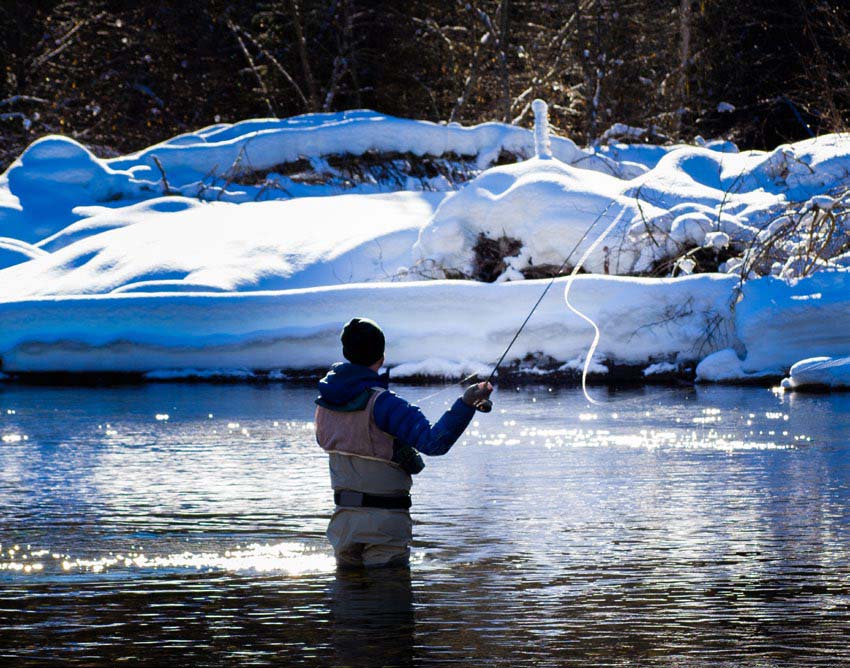“I remember thinking: it looked like a good trout river.”
So thought James Baxter, a West Kootenay angler, when he first drove over the Salmo River in 1997. Little did he know then that he would come to spend the next 24 years of his life working, playing, and fishing on this river.
The Salmo is a 60 kilometre river born from the Selkirk Mountains. It winds through stands of cedar, hemlock, and Englemann spruce, and it is visited by foraging grizzly bears and breeding Harlequin ducks.
Prior to European contact, members of the Sinixt Nation — whose name translates as “people of the place of the bull trout” — came to the Salmo River from June to October, fishing for coho, sockeye, chinook, and steelhead salmon. In 1825, when Pacific Fur Company clerk Alexander Ross came to the area, he noted the river’s abundance of salmon. And today, the Salmo is becoming well known for its prized rainbow, a large trout that will easily take a dry fly, something that James Baxter has plenty of experience with.
Fishing is something James has enjoyed since he was young. Growing up in Kelowna, he often camped along the Kettle River and fished in the areas surrounding Rock Creek and Midway. One summer, his family rented a houseboat on Shuswap Lake. He and his brother fished minnows from the wharf.
“Fishing bonded us as a family,” James says. “It was a way to connect. Fishing is interwoven into the fabric of our relationship, and always gives something we can come back to when we want to spend time together. And poke fun at each other.”
It was when he was ten years old, that James’ love for fly fishing was fostered after going on a canoe trip on the Blackwater River in the Chilcotin.
“It’s a canoe trip that I will never forget because it’s where my dad taught me how to fly fish,” James says. “The trout were eager biters, we saw eagles, we met First Nations people that didn’t speak English, and we went down a raging river that was scary yet exciting. And that passion has stuck with me through my life.”
Bull trout — Salvelinus confluentus in Latin — were the freshwater char that brought James to the Salmo River over 20 years ago. And their specific need for pristine, cold water that makes them especially vulnerable to a warming climate.
“Bull trout are an indicator of ecosystem health,” James explains. “Typically [they are] not found in systems where the water gets above 20 degrees. Where you find the stronghold of bull trout in the Salmo River watershed is in the tributary headwaters of those streams that are zero degrees or colder.”
From resource extraction to damming and railway construction, the Salmo River’s history, combined with warmer summers and winters, leaves bull trout on the hook.
“Water temperatures are increasing, and the distribution of the fish is becoming more concentrated in the summer,” James says. “This makes the fish more vulnerable to angling and catching the fish in warmer temperatures can actually cause mortality. I typically won’t fish from July 15-Sept 1 because the water is just too warm.”
And since first fishing it, James himself has seen the Salmo change.
“What I’ve noticed in the last 24 years that I’ve been working, playing or fishing on it, is that the river has changed substantially,” he says. “The summer levels are way lower. There is less stream flow or input from snowmelt. Freshet height and timing has changed, too, the duration is longer.”
“I would love to see stream flow not decline any further on this river,” James says. “My hope would be to see the bull trout population increasing or at least remain stable. I think [change] is possible. But it’s going to take some big commitments and changes to reduce the carbon impact and reverse the increasing temperature.”
While James is concerned with what he has seen over the past few decades, he hopes that the bull trout situation, and the health of their home, the Salmo River, won’t get any worse. He wants to keep fishing the river that, like other anglers in the area, he has come to love.
“It allows me to connect with the river in a way I can’t describe,” he says. “It’s a way to spend time with family and friends learning. About fishing. About what flies to use. About the clues the river gives as to where a fish may be living. And sometimes you don’t catch fish. But that’s okay. That’s why it’s called fishing and not catching.”
Anna Lamb-Yorski writes for Living Here online magazine. You can read more stories at www.livinghere.ca
By Anna Lamb-Yorski

